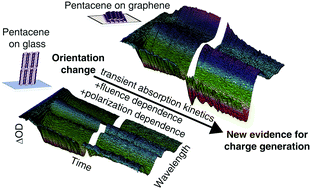Triplet exciton dissociation and electron extraction in graphene-templated pentacene observed with ultrafast spectroscopy†
Abstract
We compare the ultrafast dynamics of singlet fission and charge generation in pentacene films grown on glass and graphene. Pentacene grown on graphene is interesting because it forms large crystals with the long axis of the molecules “lying-down” (parallel to the surface). At low excitation fluence, spectra for pentacene on graphene contain triplet absorptions at 507 and 545 nm and no bleaching at 630 nm, which we show is due to the orientation of the pentacene molecules. We perform the first transient absorption anisotropy measurements on pentacene, observing negative anisotropy of the 507 and 545 nm peaks, consistent with triplet absorption. A broad feature at 853 nm, observed on both glass and graphene, is isotropic, suggesting hole absorption. At high fluence, there are additional features, whose kinetics and anisotropies are not explained by heating, that we assign to charge generation; we propose a polaron pair absorption at 614 nm. The lifetimes are shorter at high fluence for both pentacene on glass and graphene, indicative of triplet–triplet annihilation that likely enhances charge generation. The anisotropy decays more slowly for pentacene on graphene than on glass, in keeping with the smaller domain size observed via atomic force microscopy. Coherent acoustic phonons are observed for pentacene on graphene, which is a consequence of more homogeneous domains. Measuring the ultrafast dynamics of pentacene as a function of molecular orientation, fluence, and polarization provides new insight to previous spectral assignments.



 Please wait while we load your content...
Please wait while we load your content...